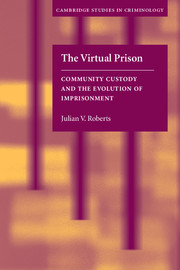Book contents
- Frontmatter
- Contents
- List of figures and tables
- Foreword by Andrew Ashworth
- Preface
- 1 Introduction to the concept of community custody
- 2 The way we punish now
- 3 Conceptualizing community custody
- 4 Representative models of community custody
- 5 Coming home to prison: offender perceptions and experiences
- 6 The effect of community custody on prison admissions
- 7 Public attitudes to community custody
- 8 Making community custody sentences work
- Notes
- References
- Index
1 - Introduction to the concept of community custody
Published online by Cambridge University Press: 07 December 2009
- Frontmatter
- Contents
- List of figures and tables
- Foreword by Andrew Ashworth
- Preface
- 1 Introduction to the concept of community custody
- 2 The way we punish now
- 3 Conceptualizing community custody
- 4 Representative models of community custody
- 5 Coming home to prison: offender perceptions and experiences
- 6 The effect of community custody on prison admissions
- 7 Public attitudes to community custody
- 8 Making community custody sentences work
- Notes
- References
- Index
Summary
Imprisonment is when a man is by public authority deprived of liberty.
(Hobbes, 1651/1957, p. 206)The contention
Prisons have failed to achieve their goals, and so, in large measure, have most of their alternatives. The failure of our prisons to reform or reintegrate offenders has been apparent since John Howard toured Europe's prisons in the eighteenth century (see Howard, 1929; Lilly and Ball, 1987; Selke, 1993). More recently, research has made it increasingly clear that prison does not deter offenders any more effectively than most community punishments (e.g. Doob and Webster, 2003; von Hirsch, Bottoms, Burney, and Wikstrom, 1999). A significant body of research has now accumulated to demonstrate the negative effects of prison, beginning with the seminal work by Sykes on the pains of imprisonment (1958). Perhaps the best that can be said of prison is that prisoners emerge no worse than when they were admitted (Zamble and Porporino, 1988), and that is not saying very much. Although prison has failed to rehabilitate, its destructive force remains undiminished.
Yet the prison continues to dominate the penal landscape, and to maintain its status as an iconic legal punishment around the world. Indeed, when asked to ‘sentence’ an offender many people's first reaction involves custody. This is particularly true for the more serious offences. Support for custody is not restricted to Western nations, as revealed by the responses to the International Crime Victimization Survey (see Mayhew and van Kesteren, 2002).
- Type
- Chapter
- Information
- The Virtual PrisonCommunity Custody and the Evolution of Imprisonment, pp. 1 - 21Publisher: Cambridge University PressPrint publication year: 2004



